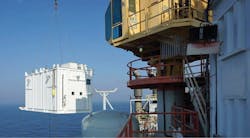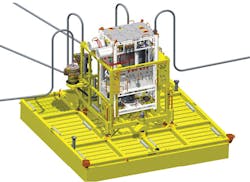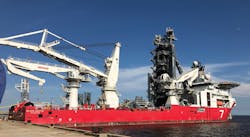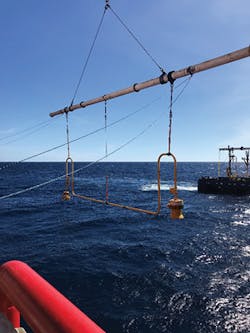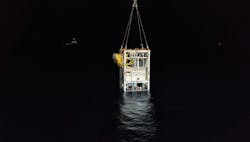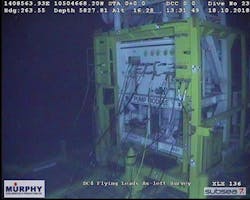Deployment of subsea pump underpins EOR project in deepwater Gulf
William M. Taggart IV, Murphy Exploration & Production
In November 2016, Murphy Oil awarded a contract to design and install a subsea pump at the Dalmatian field in the Gulf of Mexico to Subsea Integration Alliance, which is the combination of Subsea 7 and OneSubsea, a Schlumberger company. This article is about the journey, challenges, successes, and results of that project.
But first – why a subsea pump?
The Dalmatian oil well located in Desoto Canyon block 4 came online in June 2014 and proved to be a prolific well with a high productivity index, but located in a shallow reservoir with a low pressure. At 21½ mi, it was one of the longer subsea tiebacks at the time. The Chevron Petronius platform located in Viosca Knoll 786 acted as the host platform. Two years later Murphy extended the flowline another 11½ mi to Desoto Canyon block 134 to add the Dalmatian South development to the asset. The DC134#2 well proved to have a lower productivity and a lower gas-to-oil ratio. The lower GOR increased the specific gravity of the fluid. Making the fluid heavier adding backpressure to the DC4 location as the fluid made the long climb from DC4 at 5,830 ft water depth all the way to the lower deck of the Petronius host. This was compounded by the increased backpressure from increasing the flowrate in the line. These pressures, added together, resulted in a pressure at the DC4 location that the older DC4#1 well was unable to flow against. As a result, the two wells did not play nice together.The short-term solution was to flow each well individually for 2-3 months, shut in the producing well, then flow the other well for 2-3 months. This solution was limiting recovery from both wells. A permanent solution was needed to get simultaneous flow from both wells and if that solution could lower downstream pressure, increased recovery could be realized as well.
Murphy considered gas lift at the riser base of Petronius (1,780 ft water depth), gas lift at the DC4 location and in the wellbores. Gas lift proved to be limited in value. A subsea pump installed at the Petronius location was also considered, but at the 1,780 ft seafloor depth, this also proved of limited value. A pump installed at the DC4 location (5,830 ft seafloor depth) provided the most recovery. So, the decision was made to hold a design competition between the available suppliers for a subsea pump to be located at the DC4 location.
The chosen pump
After the design competition, Murphy chose the pump from OneSubsea. It was important for Murphy not to design a pump from scratch, but to choose an existing pump design that could meet the requirements. This would reduce the engineering and testing time required and also reduce the project risk by using a proven design. The selected pump was capable of handling 35,000 b/d at 0% gas vapor fraction (GVF). GVF is a measure of how much gas is entrained in the liquid for a multi-phase pump. As the gas volume increases, the pump moves less liquid and many pumps are limited in the GVF range they can operate in. The pump had a capacity of 20,000 b/d at 50% GVF. The selected pump was limited to 2,150 psi (150 bar) differential pressure from suction to discharge.The pump was equipped with a high-voltage 2.2-megawatt electric motor. This allowed for the longest step out in industry (22 mi/35 km) without subsea transformers. It also reduced the amount of hardware to be installed on the seafloor, reducing installation scope and complexity. The host platform generators supply 4,180-volt power to the variable frequency drive to control the speed of the pump. The output current is then sent to a step up transformer on the platform deck to raise the voltage and lower the amount of current to send through the 22-mi umbilical. The power is then routed through a final filter cabinet after the transformer and from there to the umbilical.
The umbilical was a 10.5 kV design with three high voltage conductors, fiber optics for communication and low voltage conductors to power the subsea control module. Eleven steel tubes were part of the umbilical, four tubes dedicated to barrier fluid, two to control fluid (hydraulic) for valve and choke operations, and five tubes were added for future field expansion.
A barrier fluid hydraulic power unit (HPU) would also be supplied. Barrier fluid is a refined mineral oil the HPU supplies at high pressure through the umbilical to the subsea pump motor. Barrier fluid is used to fill the motor housing and to seal the motor housing from the process fluids in the pump section, thus preventing water ingress to the motor housing and providing cooling for the motor.The challenges
Anytime a subsea development has to work with a host platform or host operator, the project team has to take that relationship into account. The host platform has to be considered like a neighbor’s house. You do not own the house and you have to play by the rules of the house. Any work or equipment installed on the host platform has to first and foremost conform with the host operator’s rules and requirements. This requires the project team to engage the host operator’s team as early as possible and work to get alignment on specifications and requirements. Any new equipment needs to be designed for installation on the host, and that means not only following the host’s specifications, but also designing for the host environment, layout and to leverage the host platform cranes, so as to not require a heavy lift vessel.
The existing inspectors and construction services that the host operator has used in the past, should be contacted and leveraged. These individuals have knowledge of the host, the host’s personnel and procedures, which is more valuable than any long-term relationship you may have established with other service providers.
Involvement of the host operator’s team in document review is required and the process for that review should be established as early as possible, most importantly to establish the review duration between the teams. Having an agreed duration in writing that all parties sign on to is necessary to plan the flow of documents for the project and to establish the vendor review cycle.
The subsea team needs to be aware and appreciate that the host operator’s team will have other activities on-going; well workovers, platform brownfield projects and reacting to platform events. So, the subsea team needs to be understanding and supportive of the host team’s requirements. The host will likely require separate HAZOPs and risk assessments that the subsea team shall participate in. The subsea team can adopt these risk assessments in place of their own for the host portion of the project, but should never assume that the host operator will adopt the subsea team’s risk documentation in place of their own.
One of the decisions that the Dalmatian Pump team made was to remove the pump control building from the Subsea Integration Alliance scope. This allowed the building to be designed by a local engineering firm very familiar with the host facility and to have it built in the New Orleans area where the subsea and host teams could regularly inspect. The building was not only designed to accommodate the electrical equipment to support the pump, but was also designed to be installed by the platform crane, negating the requirement for a heavy lift vessel.A lesson learned from the project in designing the building to fit in the least amount of space, no room was left inside the building for critical spare parts. Space on offshore platforms is always at a premium, but in hindsight a 3 ft (1 m) amount of wall space for shelving for spare parts should have been accommodated.
A further lesson was that the Heating/Ventilation/Air Conditioning (HVAC) system needed more specification in the design documents. The building HVAC system had been designed to handle the very large heat loads generated by the variable frequency drive for the pump housed in the building. But the HVAC system had trouble when the VFD was not operating and there was minimal heat load and also had trouble during the winter months when external temperatures were very low. The lesson learned is to stress to the vendor that the HVAC system has to operate from minimal to maximum heat load, from the dead of winter through the dog days of summer.
Schedule will always be a challenge for any project and how the team manages schedule challenges will decide the project’s fate. An early schedule challenge occurred when the subsea pump system integration testing was delayed from April 2018 to July 2018. The integration testing used the actual pump control panel, VFD drive and barrier fluid HPU for the project, which were due to be installed on the host platform early enough to permit all the interconnect work. As a result, Murphy paid extra to have this equipment air freighted to New Orleans for delivery to the platform early while the remainder of the equipment came via sea freight. This provided a critical four weeks of time offshore where interconnect cables and tubing could be installed prior to the arrival of the subsea pump.
The other schedule disruption was Hurricane Michael plowing right through the project area as subsea installation was trying to proceed. Subsea 7’s installation vessel the Seven Arctic had to make for safer waters with a two-day delay to operations and the host platform was evacuated resulting in a four-day interruption before construction activities at the host could resume. Weather delays are almost a guarantee for any offshore project and have to be addressed with contingency and planning.
A major challenge for the project was the pull tube for the umbilical which was part of the Petronius jacket structure. Petronius is a compliant tower design and the jacket was installed in two pieces. This two-piece installation meant that the J tube to be used for the umbilical was a continuous 12-in.pipe from the seafloor to the boat landing deck (14 ft above sea level), except for a 2-ft gap where the two pieces of the jacket installation met. This mid-water gap located at about ~800 ft below sea level presented an unplanned problem. The pull tube had been cleaned as part of the original preparation for the Dalmatian installation in 2013 and had a new messenger wire installed along with a debris cap on the lower section of the mid-water gap. The debris cap had a slot in it for the messenger wire. Over the next five years, exposure to seawater and abrasion on the trash cap weakened the messenger wire, and when an attempt was made to drift the pull tube one month prior to umbilical pull in, the messenger wire parted just below the mid-water gap. What followed was three weeks of a project team reacting to an unplanned event in a controlled and disciplined manner. Work progressed to get the old broken wire removed, the debris found in the bottom of the J tube dredged out, and a new messenger wire installed to maintain the umbilical installation schedule.Installation
The subsea installation campaign began in April 2018, when the pump foundation was installed at DC4 by Subsea 7’s vessel the Seven Seas. This was followed in August 2018 when the flowbase was installed and the J-tube for the umbilical was drifted. In September 2018, the Seven Arctic took possession of the umbilical from Aker at their facility in Mobile, Alabama. The 22-mi umbilical was transpooled into the Seven Arctic’s underdeck carousel and the vessel then transited to Petronius where the umbilical was pulled through the J tube to the platform. The umbilical was then laid to the vicinity of the flowbase where the subsea termination unit was landed on a mudmat installed on the seafloor.
In October 2018, the main and final installation campaign began with flushing and removal of the two existing jumpers. It was at this time that Hurricane Michael disrupted activities at the Dalmatian site and at the Petronius host platform. The construction effort restarted with the installation of three new rigid pipe jumpers and the subsea pump module. The final installation scope was also conducted by the Seven Arctic, supported by Jones Act compliant offshore supply vessels.
Commissioning
Commissioning activities were split up with the responsible party commissioning their area of responsibility. Chevron commissioned the utilities and power supplied to the barrier fluid HPU and electrical drive; while OneSubsea commissioned the topsides electrical equipment and barrier fluid HPU. Murphy used a third party to flush and commission all the interconnect tubing on topsides. Subsea 7 tested and commissioned the rigid jumpers. Finally, OneSubsea commissioned the subsea pump module with a final ramp up to full power test and then a 48-hour run test, which was the project completion milestone.
Achievements
The Dalmatian field development project had a number of notable achievements. These included:
• Longest step out for a subsea pump – 22 mi/35 km
• Successfully leveraged industry standards and industry capability
• Safely done – 0 recordables for 184,000 manhours
• Sanctioned as 24-month project, accomplished in <23 months and within budget
• Achieved steady state operations within three days of startup
• Planned downtime of 10 days for Dalmatian Wells, was actually nine days for project and four days for Hurricane Michael
• Small project team – ~7% of capex.
Conclusions
While the technology deployed proved invaluable and the installation procedures were state of the art, the purpose of the project was to improve recovery from the Dalmatian field. So, what were the results? Average production prior to the pump was ~3,500 b/d of oil when the operators were individually cycling the wells. After pump installation, the wells were able to flow together, and production was increased to ~10,500 b/d of oil.
For maturing deepwater oil fields, subsea pumps are an especially effective way of increasing recovery and should be considered as one of the options in our toolbox for increased recovery options. This is especially true where the fields lack aquifer support and are located in deepwaters, which was the case for the Dalmatian field. •
The author
William M. Taggart IV is Senior Engineering Advisor for Murphy’s Western Hemisphere Offshore and has held different positions at Murphy for the last 14 years. Previously he was a consulting engineer with Waldemar S. Nelson & Co. in New Orleans for 16 years working on various projects in industry including the Shell Ursa and BP/Shell Na Kika projects.
Acknowledgments
Murphy would like to thank EcoPetrol our partner in Dalmatian, Chevron as the Petronius operator, and Subsea 7 and OneSubsea as the EPCIC contractors, and all the other contractors, vendors, inspectors, and personnel that made this project successful.
